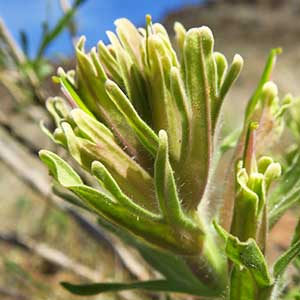Castilleja xanthotricha
Castilleja gracillima
John Day or yellow-hairy paintbrush, John Day paintbrush, yellow hair paintbrush, yellow-hair Indian paintbrush
slender Indian paintbrush, slender paintbrush
few to several, ± decumbent to erect or ascending, unbranched, sometimes with short, leafy axillary shoots, hairs erect to spreading, long, soft, eglandular, mixed with short stipitate-glandular ones.
solitary, sometimes few, proximally creeping, becoming rhizomatous, erect to ascending distally, unbranched, sometimes branched, often glabrate proximally, hairy distally, hairs spreading, medium length and long, soft, mixed with much shorter stipitate-glandular ones near inflorescence.
green, linear, lanceolate to broadly lanceolate, oblong, or cuneate, 0.8–5 cm, not fleshy, margins plane to wavy, involute, 0–5-lobed, apex acute, sometimes rounded;
lobes spreading, linear, arising below mid length, nearly as broad as center lobe, apex acute.
green to purplish, linear-lanceolate to broadly lanceolate or narrowly oblong, 1.2–7.1 cm, not fleshy, margins plane, sometimes ± wavy, slightly involute, 0-lobed, apex acute to acuminate.
3–14 × 1.5–4.5 cm;
bracts proximally greenish, rarely dull reddish purple, distally white to cream, rarely pale yellow or dull, pale pink (sharply differentiated from proximal coloration), lanceolate or oblong to narrowly ovate, (3–)5–7-lobed;
lobes ascending, linear to obovate, ± broadened distally, medium, long, proximal lobes arising below mid length, central lobe apex broadly rounded to truncate, others acute to rounded.
4.5–18 × 1.5–6 cm;
bracts white, cream, pale yellow, pink, salmon, orange, or dull red throughout, or proximally greenish, distally as above, broadly lanceolate to oblong, 0–3(–5)-lobed;
lobes ascending to erect, lanceolate to triangular, often short, arising above mid length, apex obtuse or rounded, sometimes acute or acuminate.
curved, 17–23 mm;
tube 15–19 mm;
beak exserted, adaxially green, 5–8(–9) mm, puberulent, stipitate-glandular;
abaxial lip deep purple (color sometimes visible through calyx), green, pinkish, or pale yellow, ± prominent, slightly inflated, usually hidden in calyx, sometimes right at top of calyx, 2 mm, ca. 50% as long as beak;
teeth ascending, whitish, yellowish, pink, or green, 1–1.5 mm.
± straight, 19–30 mm;
tube 11–19 mm;
beak exserted from calyx, adaxially green, 7.5–11 mm;
abaxial lip deep green, reduced, 1–2 mm, 20% as long as beak;
teeth incurved to erect, green, 0.5–1 mm.
colored as bracts, 15–26 mm;
abaxial and adaxial clefts 3.5–7 mm, 25–50% of calyx length, deeper than laterals, lateral 2–5 mm, 12–25% of calyx length;
lobes linear, oblong, or narrowly triangular, center lobe apex usually rounded, lobes acute to rounded.
colored as bracts, pigmentation often confined to lobes, 15–22 mm;
abaxial and adaxial clefts 7–14 mm, 40–50% of calyx length, deeper than laterals, lateral 2–6.5 mm, 10–20% of calyx length;
lobes narrowly triangular to narrowly lanceolate, apex acute (to sometimes acuminate in Logan Valley).
= 48.
= 48.
Castilleja xanthotricha
Castilleja gracillima
Castilleja xanthotricha is endemic to moderate elevations in the sagebrush hills of the John Day River drainage in north-central Oregon. N. H. Holmgren (1971) hypothesized that this tetraploid species is of allopolyploid hybrid origin between C. glandulifera and C. oresbia.
(Discussion copyrighted by Flora of North America; reprinted with permission.)
Castilleja gracillima populations are centered around the Greater Yellowstone region, but its range extends sporadically west to central Oregon. It is sometimes confused with C. miniata, but differs from that species in its floral dimensions, mostly single-stemmed growth form, primarily white, yellow, or pinkish orange bract coloration, puberulent stems, and weakly rhizomatous habit. Where the two grow in the same general region, there is no clear evidence of hybridization; however, C. cusickii and C. gracillima form an extensive, sporadically intergrading population in the Logan Valley, Grant County, Oregon.
Plants attributed to this species from the Rocky Mountain trench near the head of the Columbia River in southeastern British Columbia or adjacent Alberta are a combination of several other species, especially Castilleja lutescens and C. miniata.
(Discussion copyrighted by Flora of North America; reprinted with permission.)
